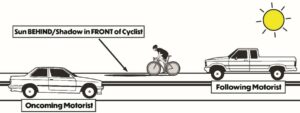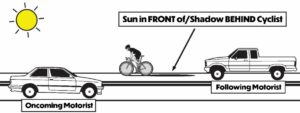
Sun glare can pose significant risks to cyclists and motorists, impairing visibility and increasing the risk of accidents. While September typically feels like a bonus month of summer here in Ohio, sun glare is dangerous for cyclists!
Key Dangers for Cyclists
Key dangers associated with sun glare for cyclists include:
1. Reduced Visibility: Sun glare can make it difficult for cyclists to see the road ahead, other vehicles, pedestrians, and potential hazards. This reduced visibility can lead to collisions or accidents.
2. Impaired Judgment: Cyclists may misjudge distances, speeds, and the positions of objects or vehicles due to the blinding effect of the sun, leading to risky maneuvers.
3. Increased Risk of Collisions: The sun’s glare can obscure traffic signals, road signs, and the brake lights of vehicles. This can make it challenging to anticipate and react to traffic situations effectively.
4. Difficulty in Spotting Obstacles: Potholes, debris, road irregularities, or obstacles become less visible when the sun is low in the sky, increasing the risk of cyclists hitting these hazards.
5. Distracted Driving: Motorists dealing with sun glare themselves may be less attentive to cyclists on the road. This can result in drivers not seeing or misjudging the location of cyclists.
Mitigating the Risks of Sun Glare Season
To mitigate the dangers of sun glare while cycling, consider the following precautions:
• Use Sun Protection: Wear a pair of sunglasses with polarized lenses to reduce glare. Consider using a helmet visor or cap with a visor to shield your eyes from direct sunlight.
• Adjust Your Route and Timing: Plan your rides to avoid cycling during peak glare times – sunrise or sunset – when the sun is at its lowest and most blinding. Choose routes with tree cover or buildings that can provide shade.
• Increase Visibility: Make sure you are highly visible to other road users. Wear bright fluorescent and reflective clothing. Equip your bike with front and rear lights, even during daylight hours. When the sun is behind you, turn your lights on full blast.
• Maintain a Safe Following Distance: Increase your following distance behind vehicles, especially when dealing with bright sunlight and sun glare. This allows more time to react to sudden stops or obstacles.
• Ride Defensively: Assume that others on the road may have reduced visibility due to sun glare. Be extra cautious at intersections, when changing lanes, and when passing or being passed by vehicles.
• Slow Down: Reduce your speed in areas where sun glare is particularly intense or when visibility is compromised.
• Communicate: Use hand signals to communicate your intentions to drivers and other cyclists, and make eye contact when possible to ensure that you have been seen.
Time of Day and Location Affect Your Blind Spot!
Sun glare is dangerous for cyclists given their greater vulnerability in the face of motor vehicles. It can also vary depending on time of day and location. Always stay vigilant and adapt your riding style accordingly to stay safe on the road. Know your blind spot! The following illustrations help cyclists determine their active blind spots.
When the sun is to a cyclist’s back, their blind spot is in front of them, potentially reducing their visibility:

Cyclists need to be extra vigilant to mitigate the dangers of sun glare! Oncoming motorists turning left may be experiencing sun glare.
When the sun is in front of a cyclist, their blind spot is behind them:

A following motorist may be experiencing sun glare and not see the cyclist.
Take it from an experienced Cleveland bicycle accident lawyer, awareness of and adapting to sun glare can make all the difference for safer cycling! And of course be sure to protect yourself with insurance.
Disclaimer: The following blog contains suggestions for cyclists on the road during sun glare season. It in no way negates a motorist’s responsibility. Their legal duty to see what is on the road, be aware of their surroundings and mindful of cyclists.
Ken Knabe, Greater Cleveland’s Bike Attorney promoting cycling safety and representing cyclists injured by careless drivers. 14222 Madison Avenue Lakewood, OH 44107 (216) 228-720
